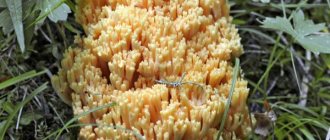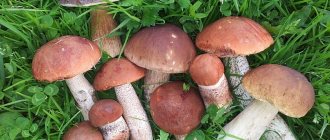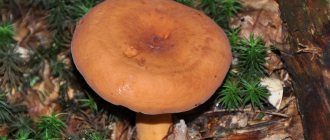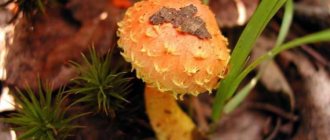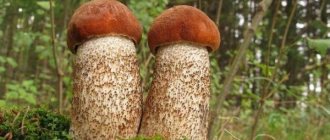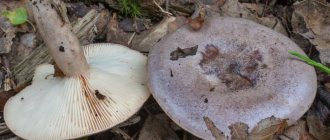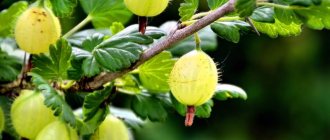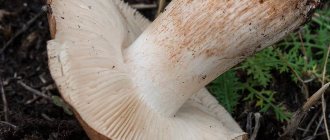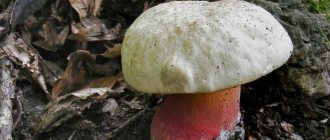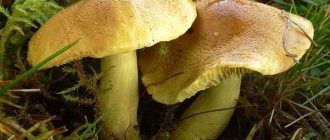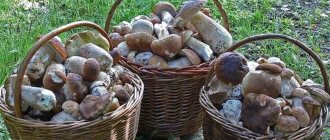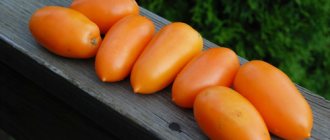Mushrooms
1
1768
Article rating
Kira Stoletova
There are many types of mushrooms that are used in cooking and medicine. The semi-white mushroom also belongs to them; it is also called yellow boletus. It is often found in coniferous and moist deciduous forests between May and the end of September.
Description of the semi-white mushroom
Description
The semi-white mushroom has a cap from 6 to 21 cm. At the beginning, in young boletes, it is convex, and over time it becomes cushion-shaped or prostrate. The skin on the cap can be smooth or velvety.
Its color is:
- clay-ocher;
- light gray;
- brown.
The tubular layer has the following tones:
- lemon yellow;
- golden yellow;
- yellow-green.
The leg has a height of 6 to 10 cm and a diameter of 3.5 to 6 cm. Its upper part is yellow, the base is dark brown, and sometimes has a red belt. The appearance of the leg is squat, tuberous-swollen, and over time it becomes rough, cylindrical or fibrous.
Did you know? Mushrooms are much older than dinosaurs; scientists agree that boletes have been living on the planet for 400 million years. Of the existing species, only ferns can boast of the same age. Moreover, unlike them, which were quite crushed, the modern mushroom is practically no different from its ancestor.
The pulp is quite thick and has a bright yellow tint. When cut, the color remains virtually unchanged. In rare cases, in overripe representatives, the flesh may turn slightly pink or blue, but not immediately, but within half an hour. The raw mushroom tastes slightly sweet, its smell gives off carbolic acid.
What do semi-white boletus mushrooms look like?
The semi-white boletus has a fairly standard structure for a boletus. At a young age, his cap is convex and half-spherical, later it becomes flattened and cushion-shaped, and reaches 15 cm in diameter.
The cap is covered with a thin but tightly fitting skin, smooth to the touch and matte, but often wrinkled in adult fruiting bodies. Usually dry, but in rainy weather mucus may appear on it. The color of the semi-white mushroom Boletus Impolitus can be clay or light brown; the lower surface of its cap is tubular and yellowish, with small pores that acquire an olive tint with age.
The leg can rise up to 15 cm above the ground, reaching about 6 cm in girth. In its lower part there is a noticeable thickening. The color of the leg is predominantly beige, being lighter in the upper part and much darker in the lower part and sometimes with a reddish tint. There are also villi at the bottom of the stem, but there is usually no mesh pattern on its surface.
If you break a semi-white mushroom in half, the flesh will be dense, whitish or lemon-yellow, with a neutral or weak carbolic odor. The pulp does not change color due to contact with air - this is a characteristic feature of the semi-white boletus.
Edibility
According to experienced mushroom pickers, this type of mushroom is considered one of the most delicious. According to the official classification of mushrooms, half-white mushrooms belong to category No. 2. But in some sources you can find information according to which hemileccinum impolitum is considered conditionally edible.
Did you know? Despite the fact that when dried, 80% of the water is removed from mushrooms, they still remain a fairly high-calorie product, since the amount of protein in them ranges from 0.9 to 3.3%.
This is due to the specific smell that is released when the plant is collected. Although when boiled, all unpleasant discharge disappears. Prolonged drying also helps in the fight against aroma.
How to cook porcini mushrooms
The semi-white mushroom is considered a universal mushroom - it can be boiled, fried, pickled, salted and dried for long-term storage. Before any processing method other than drying, the fruiting bodies must be cleaned of forest debris, trimmed if necessary and soaked for an hour to remove slight bitterness from the pulp. Boletes are boiled for about half an hour in salted water; the broth must be drained, as toxins may remain in it.
Marinating semi-white bolet
A popular cooking method is marinating the semi-white mushroom. The recipe looks very simple:
- 1 kg of fruiting bodies is boiled for half an hour;
- the broth is drained, and the mushrooms are placed in a colander;
- in another bowl, boil water with 2 large spoons of salt, 1 large spoon of sugar, 3 buds of cloves and 5 peppercorns;
- after boiling, pour 100 ml of vinegar into the marinade and add boiled mushrooms;
- After another 15 minutes, remove the mushrooms and marinade from the heat.
After this, prepared sterile jars are laid with onions along the bottom, mushrooms are placed on top and poured with hot marinade. The containers are tightly closed and stored in the refrigerator after cooling.
Frying semi-white mushroom
Another popular recipe for semi porcini mushroom is sautéing. In a hot frying pan, greased with vegetable oil, fry 200 g of chopped onions until transparent.
After this, pre-boiled and chopped semi-white mushrooms are added to the onions, after 10 minutes the mixture is salted and peppered to taste, and after another quarter of an hour, removed from the stove. Fried boletus mushrooms can be served with boiled potatoes, porridge and other dishes.
Application
Yellow boletuses, like all edible mushrooms, have a certain amount of useful substances.
Important! The yellow boletus itself does not have any substances that have a harmful effect on the human body. But do not forget that boletes draw toxic contents from the soil. Therefore, these plants should be collected away from hazardous industries and highways.
By eating this impolitus, you can compensate for the deficiency in the body:
- B vitamins;
- amino acids;
- zinc;
- proteins that are easily digestible.
The use of the semi-white mushroom helps people put their nervous system in order, improve the condition of their hair and skin, and also has a beneficial effect on the endocrine system.
In cooking
This species has excellent taste and tender flesh.
You will be interested to know how to deliciously prepare creamy porcini mushroom soup.
Like all boletus, yellow boletus can be prepared in different ways:
- marinate;
- salt;
- cook;
- bake;
- dry.
According to culinary specialists, pickled semi-white mushroom is no different from its white counterpart. These boletes are used in the preparation of main dishes and as a side dish. They are fried with potatoes and meat, added to salads, but the most popular dish is the soup made from this representative of the mushroom kingdom. Descriptions of detailed recipes can be easily found on the Internet.
In medicine
Even in ancient times, people knew about the beneficial medicinal properties of this plant species. They were used for tinctures and broths. To this day, books on folk medicine describe various recipes using the semi-white mushroom, which is mainly used as a sedative.
Important! There are inedible look-alikes. They are called inedible boletus and root boletus. They have a lighter color, unlike the semi-white mushroom, and a sour taste. The cut of these boletes is dark blue.
According to official medical sources, these diseases are:
- prevent cancer;
- improve the functioning of the immune system;
- treat viral diseases;
- improves brain function.
In cosmetology, this type is used for compresses that improve skin and hair.
Are semi-ceps mushrooms edible or not?
Although semi-white boleth does not have a very pleasant odor, after initial processing this odor disappears. From the point of view of edibility, boletus of this species is completely suitable for food consumption. According to many mushroom pickers, it is in no way inferior to the porcini mushroom, and even surpasses it in taste.
Attention! Eating semi-white boletus is not only tasty, but also healthy. Thanks to its high amount of antioxidants and vitamins, it has a beneficial effect on the immune system and brain activity.
False doubles
Like all mushrooms, hemileccinum impolitum has twins. The most similar of them is the maiden boletus; it differs from the yellow boletus only in its darker top and cone-shaped leg. Also, the semi-white boletus looks like a green moss. This twin can be identified by its thinner stem and large pores.
Naturally, we should not forget that the semi-white mushroom is similar to its white older brother and differs from it in a more yellow color. Hemileccinum impolitum is a worthy representative of the mushroom kingdom. Despite the fact that this species is rare in our region, it has beneficial and nutritional properties. The semi-white bolet can decorate the basket of any “quiet hunter”.
Time and place of fruiting
The semi-white mushroom or yellow moss mushroom prefers damp areas and is found in floodplains of oak, hornbeam and beech forests, and extremely rarely under coniferous trees. Loves clayey, moist soils. Chooses warm places, can be found in the forests and forest-steppes of Europe, Polesie and the Carpathian region, in Russia in the center and south of the European part. In Kuban it can be found in the foothills and mountain zones, on the border with other regions.
Fruiting time is from May to the beginning of winter. It does not occur every year, but if it grows, it grows abundantly.
Video
Nutritional value and chemical composition
More than 89 percent of semi-white mushrooms are composed of water. But they also contain a large amount of dietary fiber, mono- and disaccharides, unsaturated and saturated fatty acids. In addition, boletus mushrooms are an excellent source of B vitamins, particularly B3 and B5. They also contain small amounts of thiamine, riboflavin, folic, ascorbic and pantothenic acids.
As for minerals, boletus contains the most potassium, phosphorus, calcium, sulfur, sodium and chlorine. The nutritional value of fried boletus mushrooms is approximately 54 kcal/100 g.
Danger of use
The half-white boletus is not poisonous. However, when using it, you should follow some rules:
- Don't eat too many mushrooms.
- It is best to eat bolet at lunch or in the evening, but no later than a few hours before bedtime.
- Try to combine mushrooms with a variety of side dishes. Eating large amounts of “pure” mushrooms can cause severe heartburn.
You should avoid consuming yellow boletus mushrooms in the following cases:
- Age up to 10 years. Children's digestive system is not yet fully developed. Eating yellow boletus, especially in large quantities, can lead to colic, abdominal pain, and belching. The mushroom contains a large amount of fiber, which is not very suitable for a child’s stomach.
- The semi-white bolete contains disaccharides. In this regard, people with diabetes mellitus type 1 or 2 should eat it with extreme caution. And it is best to completely exclude the semi-white mushroom from your diet.
- Also, people who have serious kidney problems should not eat mushrooms. This is due to the fact that such products may contain an increased concentration of nitrates.
In addition, do not forget that the semi-white boletus, as well as other mushrooms, is capable of absorbing various toxins and other harmful substances from the soil and air. So you should not collect them in close proximity to highways and other polluted places.
Breaded porcini mushrooms with herbal mayonnaise
Clean the mushrooms: Trim the earthy part of the base, clean the stems and caps, then wipe them with a damp cloth to remove any remaining dirt.
Ingredients for Breaded Porcini Mushrooms:
- 14 ounces porcini mushrooms
- 2 eggs
- 2 egg yolks
- Breadcrumbs
- Powder
- parsley
- Thyme
- Marjoram
- Vinegar
- Lemon
- Peanut butter
- Salt
- Pepper
Instructions for making Breaded Porcini Mushrooms:
- Clean the porcini mushrooms, cut off the earthy part of the base, clean the stems and lids, then wipe them with a damp cloth to remove any remaining dirt.
- Slice the mushrooms about 1/2 inch thick, dredge them in flour, then dip them in 2 eggs, beaten together with a pinch of salt and pepper, and coat them in breadcrumbs.
- Chop the herbs. Heat 2 tablespoons of vinegar and pour it into a bowl, add the egg yolks and beat with an electric hand mixer for a few seconds, then slowly add 2 tablespoons of oil, continuing to beat until it reaches the consistency of mayonnaise.
- Add half a lemon, a pinch of salt and chopped herbs to the juice.
- In a large, high-rimmed saucepan, add about 1 quart of oil and heat to 375°F. Fry a few mushrooms for a few minutes, then drain them on paper towels.
- Serve immediately with mayonnaise and fresh marjoram leaves
Where, when and how does it grow
Boletus mushrooms are quite heat-loving. As a rule, they grow in damp beech, hornbeam or oak forests. Most often found next to oak trees. They prefer clay soil. They can also sometimes be found in some coniferous forests, especially pine forests.
Distributed mainly in forest and forest-steppe zones of Europe. Actively bears fruit from the end of May until autumn. Fruiting is not annual, but sometimes quite abundant. Can grow either alone or in groups.
Difference from similar species
Many mushroom pickers confuse semi-white mushrooms with their close relatives - porcini mushroom and boletus mushroom.
Porcini
Maiden's boletus
The difference lies in the specific smell of the semi-white mushroom, which gives off carbolic acid, as well as the distinctive color of the pulp. It can also be confused with a mushroom such as deep-rooting boletus. It has an extremely bitter taste, and in appearance it is distinguished by the gray color of the cap and yellow pores.
Growing at home and in the country
Boletus mushrooms are very popular, and therefore they are increasingly grown in household plots. To do this, it is enough to bring overripe fruits from the forest, soak them for a day in water, which is then poured onto the ground under the selected tree. The harvest can be harvested after at least 2 years.
You can also bring mycelium from the forest. When digging, you need to make a depression of at least 15 cm, with a radius of up to 30 cm. Such prey should be carried very carefully. In the garden, mycelium is planted in the chosen place to a depth of no more than 7 cm, then it must be well watered and covered with foliage.
Important! The place for planting forest fruits should be shaded.
